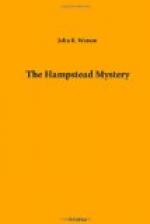“The dead body of Sir Horace Fewbanks, the distinguished High Court judge, was found by the police at his home, Riversbrook in Tanton Gardens, Hampstead, to-day. Deceased had been shot through the heart. The police have no doubt that he was murdered.”
But the morning papers of the following day did full justice to the sensation. It was the month of August when Parliament is “up,” the Law Courts closed for the long vacation, and when everybody who is anybody is out of London for the summer holidays. News was scarce and the papers vied with one another in making the utmost of the murder of a High Court judge. Each of the morning papers sent out a man to Hampstead soon after the news of the crime reached their offices in the afternoon, and some of the more enterprising sent two or three men. Scotland Yard and Riversbrook were visited by a succession of pressmen representing the London dailies, the provincial press, and the news agencies.
The two points on which the newspaper accounts of the tragedy laid stress were the mysterious letter which had been sent to Scotland Yard stating that Sir Horace Fewbanks had been murdered, and the mystery surrounding the sudden return of Sir Horace from Scotland to his town house. On the first point there was room for much varied speculation. Why was information about the murder sent to Scotland Yard, and why was it sent in a disguised way? If the person who had sent this letter had no connection with the crime and was anxious to help the police, why had he not gone to Scotland Yard personally and told the detectives all he knew about the tragedy? If, on the other hand, he was implicated in the crime, why had he informed the police at all?
It would have been to his interest as an accomplice—even if he had been an unwilling accomplice—to leave the crime undiscovered as long as possible, so that he and those with whom he had been associated might make their escape to another country. But he had sent his letter to Scotland Yard within a few hours of the perpetration of the crime, and had not given the actual murderer time to get out of England. Was he not afraid of the vengeance the actual murderer would endeavour to exact for this disclosure which would enable the police to take measures to prevent his escape?




